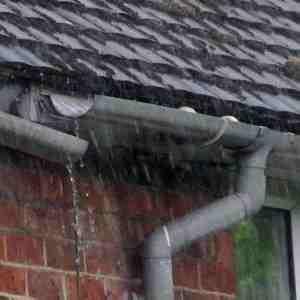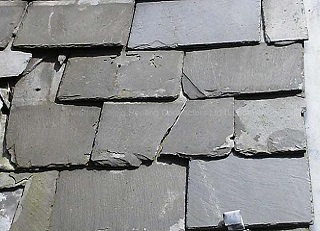The DIY Fix is reader supported. When you buy after clicking a link on our site, we may earn an affiliate commission.
Penetrating damp is caused when water penetrates through the walls or roof of a property. Once the water has penetrated, it will often expand horizontally across walls and ceilings.
The extent of the damage will be determined by the length of time the damp has gone untreated – and the extent of the problem that has caused it. The vast majority of cases of penetrating damp are caused by structural or building defects.
Therefore the most important thing about damp that is caused by building defects is that the defect itself is fixed prior to internal damp treatment being carried out. Here are some of the most common penetrating damp solutions and costs.
Identifying the source of the problem
As we’ve already established, penetrating damp is caused by water leaking through a wall or roof. The defect that is allowing this to happen could be cracks in a wall, faulty roof tiling or guttering.
It can also be caused by internal leaks too – most commonly leaking pipes under a sink or a bath. Identifying where the defect is and the root cause of the penetrating damp isn’t usually too difficult. Where you spot the damp patches emerging will usually lead you to the defect.
Guttering Penetrating Damp Solutions
 If a damp patch appears at the height of the guttering, starting your search by checking out the state of the downpipes and guttering makes sense. One of the most common penetrating damp solutions is maintaining (or repairing) your guttering system. As a preventative measure, if at all possible, guttering should be checked twice a year because even gutters that become blocked with debris and leaves can lead to damp problems.
If a damp patch appears at the height of the guttering, starting your search by checking out the state of the downpipes and guttering makes sense. One of the most common penetrating damp solutions is maintaining (or repairing) your guttering system. As a preventative measure, if at all possible, guttering should be checked twice a year because even gutters that become blocked with debris and leaves can lead to damp problems.
- Gutter sealant can be used to fix isolated cracks in guttering. Typically, however, this type of action doesn’t usually last for a particularly long time. If there is more than just one crack, it is usually best to replace the gutter instead of just trying to patch it up.
- Replacing a single gutter typically costs approximately £35 per metre. As a rough guide, replacing all (worst case scenario) the guttering in a typical 3-bed semi is likely to cost between £500-650. If extra/new downpipes are required, this would normally cost around £100.
Roofing and Brickwork Penetrating Damp Solutions
 A roof is a common source of defects related to penetrating damp.
A roof is a common source of defects related to penetrating damp.
- Missing or cracked tiles are the most common problems – particularly roof ridge tiles (these are the tiles that are at the very top of a roof and are triangular-shaped). Pointing, the cement between tiles; and flashing- where the roof meets a chimney wall, are other places to check for defects.
- Pointing should be almost flush to brickwork. If it’s not, or if it comes away when you insert a finger into it then it can cause penetrating damp as water will get through. Re-pointing can be a fairly expensive job – around £20 to £30 per metre. It can be done as a DIY job, but poorly executed re-pointing will only need to be done again in the relatively near future. It is important that the old mortar is scraped away to a depth of 12mm, not merely ‘filled over’.
- Flashing – In terms of defects around chimney walls, lead apron flashing is the easiest and cheapest of flashing penetrating damp solutions, as it is essentially ‘plugged’ into the wall. Step flashing is trickier as the angles need to be cut to fit the pitch of the roof. Removing this can be time-consuming and costly, as several tiles may need to be moved. Replacing all the leadwork around a chimney could cost you between £500 and £800.
Window and Door Penetrating Damp Solutions
 The frames around windows and doors can cause issues if they have gaps or develop cracks around them. These sorts of defects are relatively easy and cheap to fix.
The frames around windows and doors can cause issues if they have gaps or develop cracks around them. These sorts of defects are relatively easy and cheap to fix.
- Sealant can often be used and is an easy and cheap solution.
- Drip groove is a simple device that should stop water going onto the wall. If there isn’t one, a hardwood strip can be fixed to solve the issue.
- Weatherboard– To protect external doors from heavy rainfall, a weatherboard can be placed above the door to deflect water away. Any cracks around doors should also be repaired.
Cavity Penetrating Damp Solutions
 Installing a new cavity tray – If the cavity tray in your property is defective (or there isn’t one), this will need to be addressed. This is a relatively inexpensive penetrating damp solution. A basic new tray for a one metre wall is likely to cost around £350.
Installing a new cavity tray – If the cavity tray in your property is defective (or there isn’t one), this will need to be addressed. This is a relatively inexpensive penetrating damp solution. A basic new tray for a one metre wall is likely to cost around £350.
- Clearing blocked cavities is much cheaper than having to install a new cavity tray. This just involves clearing out debris (often pieces of broken brick) from the cavity.
Conclusion
It is important to remember that penetrating damp nearly always starts because of a building defect of some sort, so it pays to check around your property regularly. At the first sign of damp, identify where the defect is and deal with it as soon as possible. This will most likely limit the cost of penetrating damp solutions, and any additional work that may be required due to internal damage




